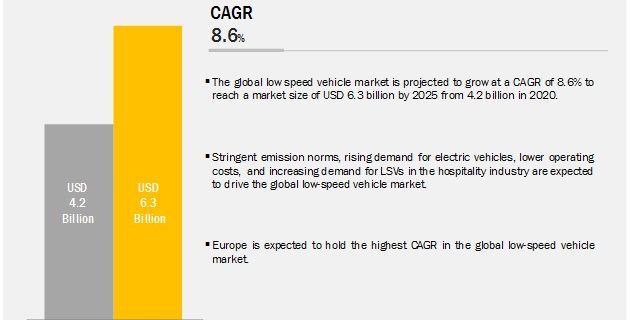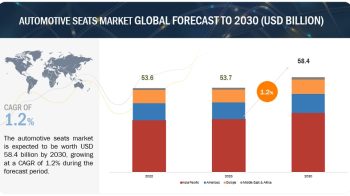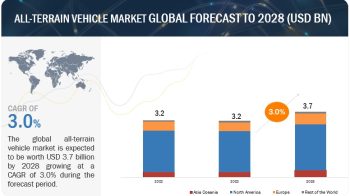
The repor “Low-Speed Vehicle Market by Type (Commercial Turf & Industrial Utility Vehicle, Golf Cart, and Personal Mobility Vehicle), Power Output (<8 kW, 8-15 kW, and >15 kW), Propulsion (Diesel, Electric, and Gasoline), Application and Region – Forecast to 2025″, The global low-speed vehicle market is projected to grow at a CAGR of 8.6% to reach a market size of USD 6.3 billion by 2025 from 4.2 billion in 2020. The rising trend of using LSV in hotels & resorts, industrial facilities, golf courses and college campuses is projected to fuel the demand of these vehicles.
“Electric Low-Speed vehicles to have the largest market among other types of propulsion.”
The growing trend towards electrification, zero-emission, and lower operating cost, the electric LSV are estimated to have the largest market during the forecast period. The battery is the power source for electric vehicles. Presently, battery costs almost one-third of the total electric vehicle price. It is observed that the battery prices, which were more than USD 1,100 per kilowatt-hour in 2010, have fallen 87% in real terms to USD 156 per kilowatt-hour in 2019. OEMs and battery manufacturers are working towards the development of high energy density battery to deliver more distance coverage on a single charge. Since the automotive industry is moving towards electric vehicles, a similar trend is being observed in the LSV segment too, where key vehicle types are golf cars and personnel carriers. The electric LSV are a better fit option as the LSV is required for short distance coverage and can be used for low power output.
Download PDF Brochure @ https://www.marketsandmarkets.com/pdfdownloadNew.asp?id=1965274
“>15 kW power output market to grow at the fastest pace in the low-speed vehicles market for North America”
Based on the use and the terrain, the power output or the vehicle type of LSV is been considered. The market for the high-power output (>15 kW) segment is expected to showcase the highest growth during the forecast period. High power output vehicles are found in all types of LSV such as commercial turf utility vehicles, industrial utility vehicles, and personal carriers. The demand for high-speed LSVs is increasing with the increase in the speed limit and government permission to ride it on selected roads and high-speed capability requires high power output.
Key Players:
The key companies profiled in the study are Ingersoll Rand plc (US), Textron, Inc. (US), Deere & Company (US), The Toro Company (US), Kubota Corporation (Japan), Yamaha Motor Co., Ltd. (Japan), Polaris Industries, Inc. (US), American Landmaster (US), Columbia Vehicle Group (US), HDK Electric Vehicle(US) and Suzhou Eagle Electric Vehicle Manufacturing Co., Ltd (China).
Key questions addressed by the report
- What would be the demand for the low-speed vehicle by vehicle type and region?
- How will the low-speed vehicle market shape up in the future?
- What are the current and future trends in the low-speed vehicle market?
- How the penetration of low-speed vehicles by propulsion type varies by region?
- Which are the key players in the global low-speed vehicle market?
To speak to our analyst for a discussion on the above findings, click Speak to Analyst


